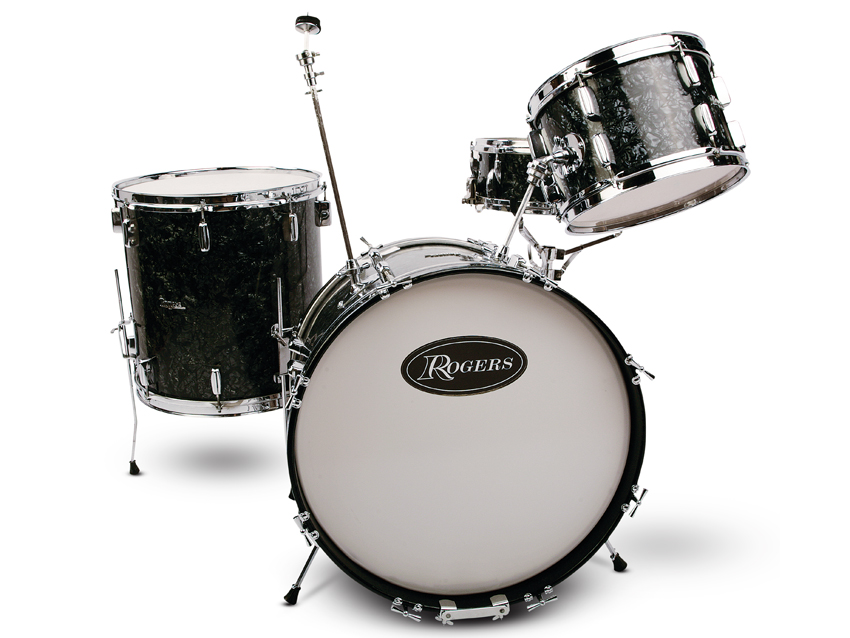Vintage drum gear: English Rogers kits
The strange case of American Rogers drums made in North London

English Rogers kit in Black Pearl
Each month Rhythm Magazine tracks-down and checks-out vintage gear in order to marvel at a bit of drum-making history.
This time we're looking at one of the most extraordinary stories in British drum-making, which occurred during the 1960s when a line of American-designed Rogers drums were made under licence in the Ajax factory at Edgware, North London.
According to Rogers expert Alan Watt, “The idea came from Rogers USA. Import duties inflated the cost of American products in the early ’60s and Rogers decided to find a UK manufacturer to make its drums over here.
“Ajax was chosen and a team was dispatched from the USA to negotiate the details. The drums were made between 1961 and 1967.” So English Rogers are simply Ajax shells with Rogers fittings. A cosmetic job.

English Rogers kit in Black Pearl
Our splendid Rogers kit belongs to Jeremy Peake. Jeremy bought the English Rogers because for some reason it included a Sonor snare drum, which he needed to complete a different Sonor kit. Also, Jeremy was able to match the Rogers with an Ajax snare drum in the same Black Pearl wrap.
He explains, “My 14x5-inch Ajax Pipper is from the same period with the same shell construction as the Rogers. I had it already and it looks and sounds good with the Rogers.”
So how to distinguish English from American Rogers? Checking inside the shells is the surest way. The English (Ajax) shells are mostly thin three-ply birch (occasionally beech) with reinforcing rings, while the American shells are maple, again with rings, but usually painted grey inside.
The other tell-tale sign is the English Rogers logo badge, which is horizontal with a thin underscore, while the American badge slopes upward.

English Rogers kit in Black Pearl
Jeremy bought his Rogers on eBay in spring 2009. Sizes are standard 12x8-inch, 16x16-inch and 20x14-inch. The floor tom bears the serial number 67620 inside, which Alan Watt ascribes to late 1961 to early-1962.
Jeremy adds, “The thinner, more angular ‘bow-tie’ bass drum tension rods and Ajax floor tom legs confirm this, as neither were used on later kits. All the drums have chromed brass ‘bread and butter’ lugs, which are infamous for developing cracks, while the toms have the distinctive Rogers tall profile hoops.
“The hardware features Swiv-O-Matic collets for the bass drum legs, disappearing cymbal arm and tom holder, all made in England. The American-made Rogers Swiv-O-Matic pedal also came with the kit and the snare stand is a flat base ‘Buck Rogers’, made by Walberg and Auge.
“I used the kit to take part in the Stick It To MS record breaking event in Birmingham. Out of 582 kits it was the only one I saw. It’s one of my favourite gigging kits. It looks great and has a classic vintage sound. I believe in using these old kits whenever possible, though I only take them to venues where I know they won’t be harmed.”

English Rogers double bass kit
Continuing the strange fable of English Rogers drums, we have a fabulous double bass drum kit. The kit has been owned from new by Durham drummer John Morris.
John recalls, “In 1962 I went with my father, who played side drum in the Southern Argyle Highlanders, to buy a Slingerland kit from Jeavons in Newcastle. But the shop had just got their first Rogers kit and my father said, ‘How about those? They’re beautiful.’
“He said, ‘if you can supply them with double bass drums I’ll buy them’ - he was a shrewd man! They tried to pass it off with Ajax pedals, but he said no, they’ve got to be Rogers. And I’ve worked the kit ever since.”

English Rogers double bass kit
The kit has two 20x14-inches, 12x8-inch, 16x16-inh in Grey Ripple, with Ajax shells. It’s coupled with a 14x5½-inch American-made DynaSonic snare which was added later.
At the National Drum Fair, Rogers expert Alan Watt examined the kit, noting the serial numbers. He says, “The floor tom dates to October 1962 and one bass drum to April 1963 (presumably the second one the shop had to order). The DynaSonic dates to 1974/75.”
It has the later, double-ended beavertail lugs, unlike the ‘bread and butter’ lugs on the rest of the kit. The DynaSonic snare hoop with integrated snare guard was introduced from the mid-’70s.
The Swiv-O-Matic bass pedal and hi-hat were made in America, but the other metal fittings were made under licence at the Boosey and Hawkes factory in Edgware.
Many drummers believe that English Swivo hardware is not interchangeable with American. However, Alan says this is not always the case. “You can have problems, the odd English or American-made ones that just won’t go together,” he admits. “But they mostly interchange, so switch them around until they fit. I have an English kit and I use it with an American double tom stand with no problem.”

English Rogers double bass kit
Back to owner John, who also mentions that the original cymbal stands were stolen and replaced with Memri-Loc stands. Rogers made these from 1976 onwards and they feature the original Rogers memory lock joint housings.
Rogers was the first company to do this and of course every company has copied and refined the concept since. These originals take some beating, though, for simple elegance. What a brilliant idea.
“The kit has been a fabulous investment,” says John. “It now only comes out on special occasions… But it was played constantly for many years, the only problem I’ve had being fine hairline cracks to the ends of two of the ‘bread and butter’ lugs on one of the bass drums.
“Lou Dias at Supreme Drums kindly sent me replacements. The chrome work on all the fittings has been absolutely superb and the DynaSonic is out of this world.”









